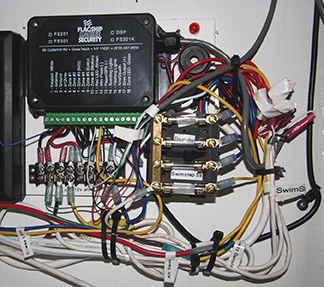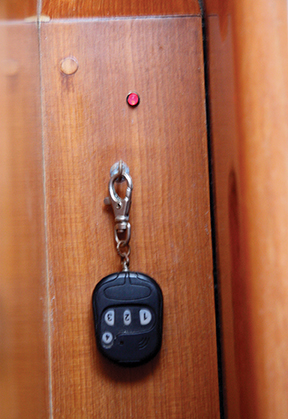How installing an alarm can boost your on board security and peace of mind (published December 2014)
Security is always a concern to cruisers. Hearing about the pirates in the Gulf of Aden or violent boardings in the Caribbean brings at least a moment of caution to even experienced cruisers and perhaps outright fear to the less well traveled.
Thinking through the possible criminal scenarios a cruiser might face and having a plan to deal with them is a first step in preparing to avoid them or diminish their impact. An obvious first part of that preparation is deciding where to cruise. Avoiding the known bad spots is probably the number one solution to dealing with crime against cruisers. Cruisers often refer to this as “Voting with your keel.” Even when you rule out known hot spots like the waters encompassed by Somali pirates or off the Venezuelan coast, there will still be many destinations that are worthy of cruising to but require some forethought and extra precaution.

Every cruiser needs to decide for themselves what they feel is worth protecting and what they might be willing to give up to protect it. For our style of cruising and living we are not that concerned about our property. In the end it is just stuff. So number one for us is to protect ourselves from danger. This would be a perfect time to segue into the to-carry-or-not-to-carry-a-gun debate. But I won’t. And we don’t.
Petty theft, burglary and robbery are found worldwide. Boats that get boarded are almost always boarded by those looking to steal goods and cash from what is to them a very rich target. The robbers are often young, early 20s or less, male and often come in teams of three or more. They are armed with knives, machetes, street smarts and sometimes guns. Typical cruisers are usually over 50, one male and one female. And the odds aren’t great for Mom and Pop in a direct confrontation in confined quarters between these groups.
BOAT ALARM BASICS
From our perspective, keeping potential robbers off your boat and helping them decide that other targets are a better choice is key to reducing your personal risk. Boat alarms contribute to this in a number of ways. To be successful, a boat alarm system needs to be used. Not occasionally, not when there’s no moon, but every night when you are on the boat and in an area that you feel has risk. An alarm system needs to have practically no false alarms. If they happen too often, then eventually the alarm will stop being used at all. It needs to be reasonably easy to install, very easy to arm and disarm, and be non-intrusive to the boat owner’s lifestyle.
The alarm system should be designed to protect various zones, or areas, on the boat. On our Outbound 44 Georgia we have three areas that we guard. The first is the swim step. It is the most inviting place to board the boat for us and for any robber. Assuming a robber got past the swim step, the next zone to protect is in front of the companionway door. It is the natural entrance to the boat.

On our boat we sleep in the V-berth. Except when it’s raining, we sleep with an 18-inch by 18-inch hatch open above our bed (in the tropics). We could protect this hatch with metal crossbars. If mounted strongly enough, they would protect us from an intruder coming in through this hatch. One downside to hatch guards is the risk of a fire onboard and having the exits blocked. Hatch guards do not offer any dissuasion to the criminals until they are already on the boat and directly at the hatch, as they are not visible from a distance. So, the area around our forward hatch is the third zone we wish to protect with an alarm system.
The areas to be protected can be grouped into two zones, pre-intrusion zone and intrusion-zone. It’s possible to come up with additional zones, but complexity is not your friend when setting up an electronic alarm system. The pre-intrusion zone is the area where the invader is attempting to board your boat, but not considered to have actually intruded on to it. At this point it may be possible to persuade him to turn around, and perhaps go home and reflect on his evil ways. But that might be a bit too hopeful.
THE SYSTEM
We want the potential intruder to leave our vessel alone and if he must, try his evil deeds on some less protected target. The pre-intrusion zone can use a number of methods to dissuade the invader. Automatically turning on stern and spreader lights when someone in the zone is detected is very effective at night. We also use a recorded audio signal at this point. In our case it is an electronic imitation of a fierce dog bark. You aren’t going to be fooled by this bark if you listen closely, but it may turn someone around who is already anxious about the risks they are taking. In some cultures, particularly in Central America, big dogs are feared even by the toughest criminals. We will certainly not be sleeping through the dog barking, which means we would have some time to prepare for an intruder.

Should the invader continue on past the swim step and approach the companionway, then we consider them to have intruded onto the boat. Stern and spreader lights begin flashing and a very loud siren alarm is sounded. Something loud enough to wake our neighbors at anchor. The area around the forward hatch is also in the intrusion zone and acts the same as the area in front of the companionway. If someone boarded the boat from the bow, say by climbing up the anchor chain or being dropped off by a silent panga, and stepped near the forward hatch the full intrusion alarm would blare.
There are a number of ways to sense intruders in these zones. Some, like motion detectors, can be very susceptible to false alarms. A bird, rain drips, flapping canvas, boat wakes and sun reflections can all cause triggering. Protecting these sensors from the elements is not easy, as they need to be mounted with clear views toward their protection area. Pressure pads are another alternative. These are simpler and less error prone. But they do still suffer from being in the elements and are cumbersome to put in place where needed.
We use strain sensors mounted below the decks as intrusion sensors. These are small strain gauges that are epoxied under the decks in the areas to be protected. Since they live inside the vessel below decks, they are not exposed to the external weather elements. These sensors work well on solid or cored fiberglass decks—even very thick and stiff layups. They can also be used on metal plate decking and cross beams. One sensor per area is usually all that is needed to protect a zone on a typical cruising boat. We use one sensor in each of our protection areas, for a total of three sensors.

For the sensors to work properly they need to be connected to a smart alarm controller. The controller needs to be able to calibrate the sensors, compensate for deck movements caused by temperature changes and ensure that no false alarms occur.
DO IT YOURSELF
Installing a system is a reasonable project. The biggest hurtles are running long wire runs from the controller to each sensor. The wires are small and there are no connectors on them, so they can be snaked through existing wire chases fairly easily on most boats. Installing the controller takes a bit of wiring and mounting. Mine came with a good wiring diagram and a reasonable, if not perfect manual.
In the instrument pod above the companionway we have a bright red LED that flashes when the alarm is enabled. This is similar to the flashing LEDs in car alarms, and I suspect most potential intruders will know its meaning and hopefully think about looking for softer targets.

WHAT ABOUT THE DINGHY?
While our focus for using our alarm system is primarily for personal safety, you can’t ignore the threat of nighttime dinghy theft while cruising. Most long-term cruisers have come up with an evening ritual to protect their dinghy: put it on davits, lift it on a halyard, place it on the foredeck, chain it to side of the boat or even insure it with a low deductible. Using our existing alarm system controller, I built a theft sensor for the dinghy.
It consists of a long four wire round cable with a loop in the far end. This loop has a bright red LED connected to two of the wires. The other two wires are the sense wires. The loop goes under the dinghy seat and through the outboard bracket when in use. The boat side of the cable is connected using a low-cost breakaway trailer wire connector. When enabled, the red LED flashes. This will hopefully dissuade the lurkers and have them heading for an easier dinghy target. If they continue on and cut the cable or yank it enough to separate it at the trailer connector, the full intrusion alarm will go off. I also put reflective tape on the outboard cover. That way I can shine a flashlight on it as they float my dinghy away and wish it goodbye for the last time.
THE RESULTS
We’ve used this system often over the last two years and it has been enabled at least 200 or 250 nights while we were on board. Over that period we have had no intruders, which is a good thing. We have had two false alarms. One was simply walking out of the companionway door in the morning pre-coffee without turning the alarm off.
The other false alarm was in a calm anchorage next to a commercial harbor in Guadeloupe. The three-foot wake of a workboat hit us hard on the stern, knocking the dinghy into the boat. It was enough to trigger the intrusion alarm. But ours is a fairly stiff boat. It would probably take less to trigger the alarm on a more flexible layup.
There are a number of vendors that sell strain gauge based alarms. The strain gauges themselves are available at a low cost, but it would take some engineering to create a controller that would make them work well as an on board intrusion alarm. We purchased our components and controller online from Flagship Marine Security (boatalarm.com) in New York.
In our experience, adding a non-intrusive, easy to enable boat alarm can be a good investment for any cruiser who wants to increase their security and enjoyment of far reaching cruising destinations.
Paul Lever and Chris Hunter have been cruising fulltime for the past four years. They’ve ranged from Seattle to Mexico, and Panama to Cape Bretton and Nova Scotia. Their Outbound 44 is currently in Curacao and heading back to Panama for another transit of the Canal. Follow their adventures at svjeorgia.blogspot.com.















